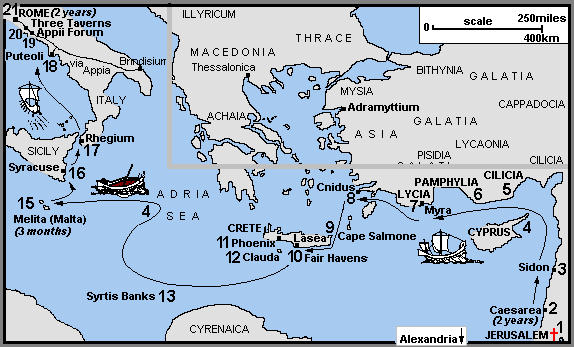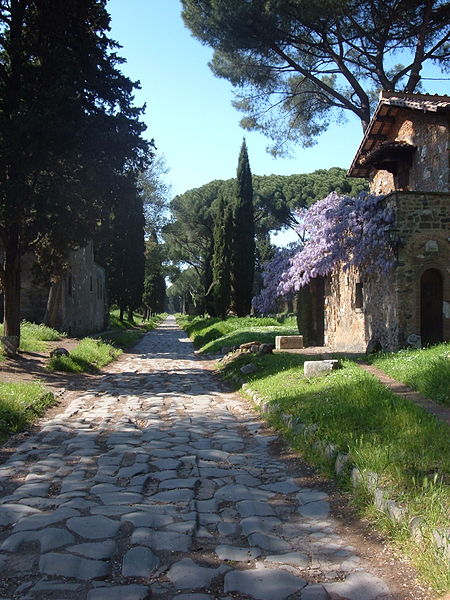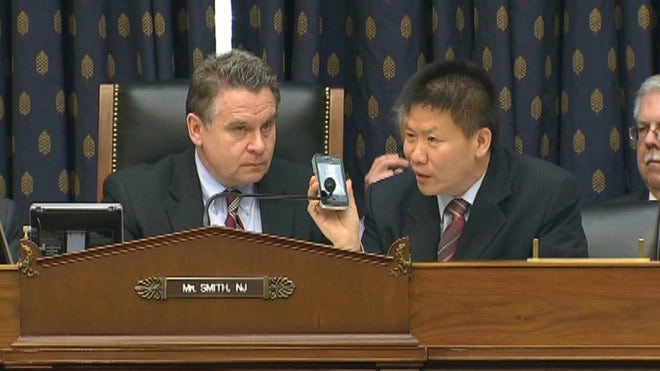BACKGROUND
Acts 21:1-3 covers location numbers 14-19 on the map above. The believers in Tyre (19) tried to persuade Paul not to go to Jerusalem, but he was following God's will and was "bound by the Spirit" to go there (Acts 20:22; 21:14).
After leaving Tyre, he traveled 20 miles by ship to Ptolemais (20). Then he traveled 40 miles (probably by sea) to Caesarea (21). Here we are reintroduced to Philip the evangelist from Acts 6:5; 8 who had apparently settled in Caesarea (Acts 8:40). His four virgin daughters all had the gift of prophecy. This shows that these gifts are not limited to just men (1 Corinthians 11:5)!
Agabus, from fifteen years prior in Acts 11:27-30, illustrated his prophecy with a belt saying Paul would be bound and delivered over to the Romans. From our Old Testament reading of the prophets, we know that it was common for prophets to prophecy using physical illustrations (Ahijah in 1 Kings 11:29-31; Isaiah 20:2-4; Jeremiah 13:1-7, Ezekiel 4). Again, the believers (including Luke) try to persuade Paul not to go, but he is resolute. In addition, he probably wanted to complete his mission of giving the offering to the needy believers of Jerusalem.
Paul went 65 miles from Caesarea to Jerusalem (22). Paul's first order of business there was to go to the leaders of the church at Jerusalem and tell them about all God had done among the Gentiles like he had done in Acts 14:27. The leaders praised God! He probably gave them the offering too.
Remember from our reading in Acts 15 how the council had settled the whole issue of the circumcision of Gentiles? Well, the issue reared its ugly head again beginning at 21:20. False rumors had spread that Paul had gone beyond that decision and forbid Jews from circumcising their children! Even though it was not true, Paul went the second mile to avoid offending the believing Jews by submitting to Jewish customs and even paying for the expenses for the purification ceremony (Numbers 6:9-20) of four men who had taken the Nazirite vow (Numbers 6:13-17). During this process, the Council at Jerusalem reiterated what they had concluded in Acts 15:20, 29.
 |
The Bible Knowledge Commentary (NT), p.
416.
|
For the sixth time, a crowd was incited because of unbelieving Jews who made false accusations (14:19; 16:19-22; 17:5-8, 13; 19:25-34). This time they accused Paul of bringing Greeks beyond the Court of the Gentiles and into the Holy Place (see the map of the temple area). In fact, the barrier separating these two places had an inscription that warned Gentiles of death if they went beyond it. Though, spiritually, Jesus broke down that barrier (Ephesians 2:14), Paul would not have taken the Greeks into the Holy Place of the temple.
Roman troops would have been stationed in the Fortress of Antonia, and the commander, Claudius Lysias (23:26), took some of these troops to rescue Paul from being killed by the rioters. After this Paul was arrested. The commander probably thought Paul was the Egyptian insurrectionist mentioned by the historian Josephus. This man came to the Mount of Olives in A.D. 54 and claimed to be a prophet. He promised that the walls of Jerusalem would collapse when he commanded it. The man escaped leaving many of his followers killed by the Roman soldiers. Quickly, Lysias learned Paul was not this man but a Jew and granted him permission to speak to the crowd.
Stay tuned for part 2 tomorrow!
REFLECTION
There is much debate about whether Paul should have submitted to ceremonial Jewish customs just to appease the Jewish believers who were skeptical about him. I love what the Life Application Bible has to say about this:
Paul submitted himself to this Jewish custom to keep peace in the Jerusalem church. Although Paul was a man of strong convictions, he was willing to compromise on nonessential points, becoming all things to all people so that he might save some (2 Corinthians 9:19-23). Often a church is split over disagreements about minor issues or traditions. Like Paul, we should remain firm on Christian essentials but flexible on non-essentials. Of course, no one should violate his or her true convictions, but sometimes we need to exercise the gift of mutual submission for the sake of the gospel. (Acts 21:23, 24; p. 2006)
Paul knew the rituals did not make men clean before a righteous God because Jesus already did that on the cross, once and for all; but it was a non-essential issue and did not hinder Paul's walk with God but helped to promote unity. The Life Application Bible goes on to make two more points:
1) Paul rejected the idea that the Old Testament laws bring salvation to those who keep them. Our salvation is freely given by God's gracious act. We receive salvation through faith. The laws are of no value for salvation except to show us our sin.
2) Paul accepted the view that the Old Testament laws prepare us for and teach us about the coming of Jesus Christ. Christ fulfilled the law and released us from its burden of guilt. But the law still teaches us many valuable principles and gives us guidelines for grateful living. Paul was not observing the laws in order to be saved. He was simply keeping the laws as custom to avoid offending those he wished to reach with the gospel (see Romans 3:21-31; 7:4-6; 13:9, 10) For more on the law, see Galatians 3:23-29; 4:21-31. (Acts 21: 23, 24, p.2006)
When I share Christ with people, I go to the Old Testament law because, in it, we understand why Jesus had to die. So, in this way, those laws help us to have a proper understanding of our faith. They are a bridge to understanding the power of Jesus', once for all sacrifice.
APPLICATION
I am passionate about people understanding the Old Testament so that they can fully grasp the New! How about you?
One fun and fulfilling way to help you understand it is by celebrating the Old Testament feasts because they all point us to Jesus.
An excellent book for understanding this is called Celebrate the Feasts by Martha Zimmerman (whom I had the pleasure of meeting once). From the back cover:
The great religious feasts as described in the Old Testament and Jewish tradition are full of spiritual truth presented in the New Testament. When those festivals are reenacted in the Christian home, children have a living picture of Bible principles. They learn far better by experiencing than by only hearing.
It is not just for children though! :) I did not learn about all of this until I was a young adult. So, there is still time for you! Go and celebrate the feasts!
Isn't it interesting that Acts 21 occurred during Pentecost?
Here is a nice little summary of this Feast:
Martha Zimmerman's book has many more ideas, recipes, and details, and I heartily encourage you to get it, especially since there are so many used copies at amazon.com!
PRAYER
Help us to firmly grasp what it means to become all things to all people so that many would come to know you! Amen.












